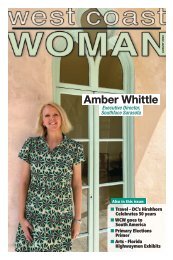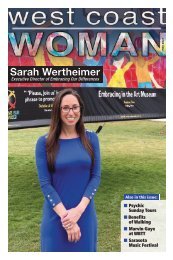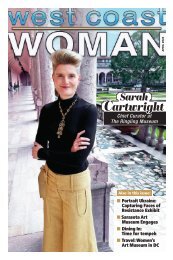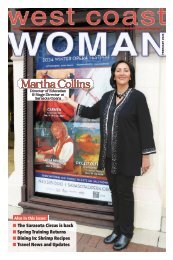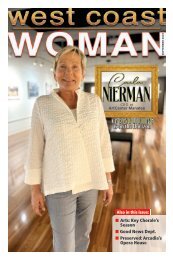wcw AUGUST 2023
Our August issue has a profile with Sarasota artist Linda Richichi. Features include a look at the Little Art Gallery’s new home, Good News Dept., Calendars, Blobfest, You're News, Travel News, Women’s Equality day and the Importance of staying hydrated. Plus, take a visit to the US Botanic Garden in DC.
Our August issue has a profile with Sarasota artist Linda Richichi. Features include a look at the Little Art Gallery’s new home, Good News Dept., Calendars, Blobfest, You're News, Travel News, Women’s Equality day and the Importance of staying hydrated. Plus, take a visit to the US Botanic Garden in DC.
Create successful ePaper yourself
Turn your PDF publications into a flip-book with our unique Google optimized e-Paper software.
happening this month<br />
Women’s Equality Day is on August 26<br />
It marks the ratification of the<br />
19th Amendment which women fought for the right to vote<br />
The right to vote,<br />
the cornerstone<br />
of democracy,<br />
belongs to all<br />
citizens — but<br />
this wasn’t always<br />
the case. Until recently,<br />
most countries denied<br />
voting rights to half of their<br />
population: women.<br />
By the early 1900s,<br />
several countries including<br />
Finland, New Zealand,<br />
and the United Kingdom<br />
had legalized voting for<br />
women as the movement<br />
continued to sweep across<br />
the world. In the early 19th<br />
century, American women,<br />
who generally couldn’t inherit property<br />
and made half of a man’s wages in<br />
any available jobs, began organizing to<br />
demand political rights and representation.<br />
In the U.S., the 19th Amendment to the<br />
Constitution was first introduced in 1878,<br />
but it failed to gain traction. It wasn’t<br />
until women’s involvement in the World<br />
War I effort made their contributions<br />
painfully obvious that women’s suffrage<br />
finally gained enough support. Women’s<br />
rights groups pointed out the hypocrisy<br />
of fighting for democracy in Europe<br />
while denying it to half of the American<br />
citizens at home.<br />
It was resubmitted numerous times<br />
until it was finally approved by both the<br />
House and Senate in June 1919. The bill<br />
needed to be approved by two-thirds of<br />
the states, so suffragists spent the next<br />
year lobbying state legislatures to gain<br />
support for the bill.<br />
Because a Constitutional amendment<br />
requires approval from two-thirds of the<br />
states, 36 of them had to ratify the 19th<br />
Amendment before its passage.<br />
On August 24, 1920, Tennessee became<br />
36th and final state to ratify the<br />
amendment, which passed by only one<br />
vote. That one vote belonged to Harry<br />
Burn, who heeded the words of his<br />
mother when she urged him to vote for<br />
suffrage. Secretary of State Bainbridge<br />
Colby signed the amendment into law<br />
on August 26, 1920.<br />
Fifty years later on August 26, 1970,<br />
Betty Friedan and the National Organization<br />
for Women organized a<br />
nationwide Women’s Strike for Equality.<br />
Women across the political spectrum<br />
joined together to demand equal opportunities<br />
in employment and education,<br />
as well as 24-hour childcare centers. This<br />
was the largest protest for gender equality<br />
in United States history. There were<br />
demonstrations and rallies in more than<br />
90 major cities and small towns across<br />
the country and over 100,000 women<br />
participated, including 50,000 who<br />
marched down Fifth Avenue in New<br />
York City.<br />
In 1971, Representative Bella Abzug<br />
Women’s rights groups pointed out the hypocrisy of fighting for<br />
democracy in Europe while denying it to half of the American<br />
citizens at home.<br />
(D-NY) introduced a successful bill<br />
designating August 26 of each year as<br />
Women’s Equality Day. Part of the bill<br />
reads that Women’s Equality Day is a<br />
symbol of women’s continued fight<br />
for equal rights and that the United<br />
States commends and supports them. It<br />
decreed that the President is authorized<br />
and requested to issue a proclamation<br />
annually in commemoration of woman<br />
suffrage and the 1970 Strike for Equality.<br />
A bit of History<br />
The 19th Amendment gave women the<br />
right to vote nationally on August 18,<br />
1920, so why is Women’s Equality Day on<br />
August 26th each year?<br />
The simple answer is that even when<br />
a constitutional amendment has been<br />
ratified it’s not official until it has been<br />
certified by the correct government<br />
official. In 1920, that official was U.S.<br />
Secretary of State Bainbridge Colby. On<br />
August 26, 1920, Colby signed a proclamation<br />
behind closed doors at 8 a.m. at<br />
his own house in Washington, D.C, ending<br />
a struggle for the vote that started a<br />
century earlier.<br />
The New York Times ran the story<br />
about the document’s signing on its<br />
front page and noted the lack of fanfare<br />
for the historic event.<br />
Colby had been asked by women’s<br />
suffrage leaders Alice Paul and Carrie<br />
Chapman Catt to allow groups in Colby’s<br />
office for the document’s signing and<br />
to film the event. Instead, Colby told<br />
reporters that “effectuating suffrage<br />
through proclamation of its ratification<br />
by the necessary thirty-six States was<br />
more important than feeding the movie<br />
cameras.”<br />
The Times explained that Colby was<br />
concerned about the rivalry between<br />
Paul and Catt and wanted to avoid a<br />
public scene at the signing.<br />
“Inasmuch as I am not interested in<br />
the aftermath of any of the friction or<br />
collisions which may have been developed<br />
in the long struggle for the ratification<br />
of the amendment, I have contented<br />
myself with the performance in the<br />
The 19th Amendment was resubmitted numerous times until it was<br />
finally approved by both the House and Senate in June 1919.<br />
simplest manner of the duty devolving<br />
upon me under the law,” Colby said.<br />
A package of documents from the<br />
state of Tennessee had arrived by train<br />
in Washington around 4 a.m. It included<br />
the official ratification document from<br />
the state legislature.<br />
How Tennessee became the 36th state<br />
to ratify the amendment on August 18,<br />
1920, was a story in itself. Congress had<br />
passed the proposed amendment a year<br />
earlier, and it was supported by President<br />
Woodrow Wilson.<br />
By the middle of 1920, 35 states had<br />
voted to ratify the amendment, but four<br />
other states—Connecticut, Vermont,<br />
North Carolina and Florida—refused<br />
to consider the resolution for various<br />
reasons, while the remaining states had<br />
rejected the amendment altogether.<br />
So, Tennessee became the battleground<br />
to obtain the three-fourths of<br />
states needed to ratify the amendment.<br />
Harry T. Burn, a 24-year-old legislator,<br />
was set to vote against the amendment,<br />
but switched his vote on the Tennessee<br />
state house floor at the urging of his<br />
mother, assuring the 19th amendment’s<br />
ratification.<br />
Yet, even after Burn’s deciding vote,<br />
anti-suffrage legislators tried desperately<br />
to nullify the previous vote.<br />
In 1971, Representative Bella Abzug<br />
championed a bill in the U.S. Congress<br />
to designate August 26 as “Women’s<br />
Equality Day.” The bill<br />
says that “the President<br />
is authorized and<br />
requested to issue a<br />
proclamation annually<br />
in commemoration<br />
of that day in 1920, on<br />
which the women of<br />
America were first given<br />
the right to vote.”<br />
In 1972, President<br />
Richard Nixon issued<br />
Proclamation<br />
4147, which designated<br />
August 26, 1972, as<br />
“Women’s Rights Day”<br />
and was the first official<br />
proclamation of Women’s Equality<br />
Day. On August 16, 1973, Congress approved<br />
H.J. Res. 52, which stated that August<br />
26 would be designated as Women’s<br />
Equality Day and that “the President is<br />
authorized and requested to issue a proclamation<br />
in commemoration of that day<br />
in 1920 on which the women in America<br />
were first guaranteed the right to vote”.<br />
The same day, President Nixon issued<br />
Proclamation 4236 for Women’s Equality<br />
Day, which began, in part: “The struggle<br />
for women’s suffrage, however, was<br />
only the first step toward full and equal<br />
participation of women in our Nation’s<br />
life. In recent years, we have made other<br />
giant strides by attacking sex discrimination<br />
through our laws and by paving<br />
new avenues to equal economic opportunity<br />
for women. Today, in virtually<br />
every sector of our society, women are<br />
making important contributions to the<br />
quality of American life. And yet, much<br />
still remains to be done.”<br />
As a footnote, the amendment certification<br />
process has changed since 1920.<br />
Now, the Archivist of the United States,<br />
who heads the National Archives and Records<br />
Administration (NARA), is responsible<br />
for finalizing the ratification process.<br />
Back in 1920, Secretary Colby’s<br />
attorney reviewed the documents that<br />
arrived from Tennessee. Today, NARA’s<br />
Office of the Federal Register reviews<br />
the documents and writes the proclamation<br />
for the Archivist of the United<br />
States to sign.<br />
Women’s Equality Day<br />
Timeline<br />
July 19-20, 1848<br />
Seneca Falls Convention<br />
The first women’s rights convention<br />
organized by women, including suffragists<br />
Elizabeth Cady Stanton and Lucretia<br />
Mott, is held at Seneca Falls, New York,<br />
sparking the movement that leads to the<br />
passage of the 19th Amendment.<br />
August 26, 1920 American Women<br />
Gain the Right to Vote<br />
The U.S. Congress adopts the 19th<br />
Amendment, also known as the ‘Susan<br />
B. Anthony Amendment,’ giving women<br />
the right to vote.<br />
30 WEST COAST WOMAN <strong>AUGUST</strong> <strong>2023</strong>



